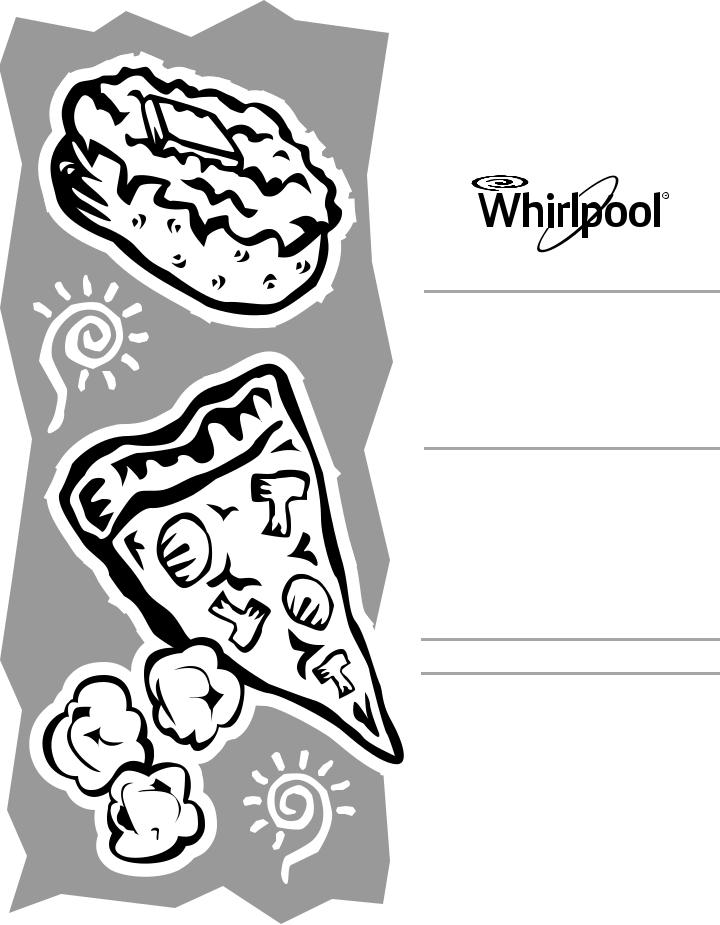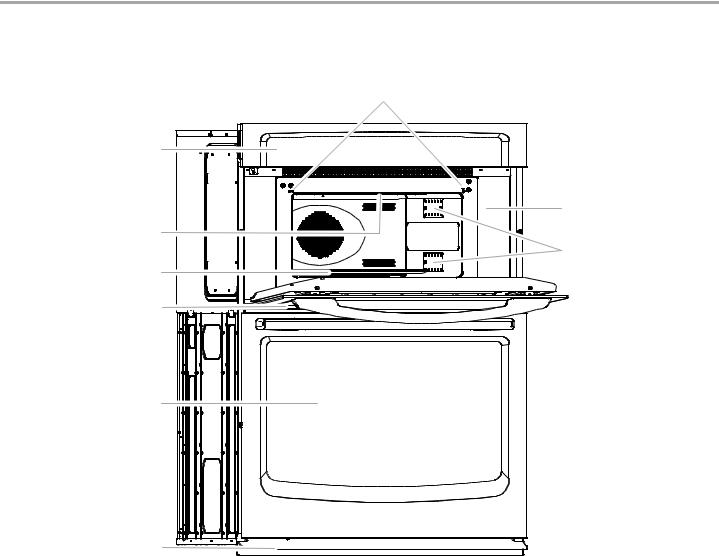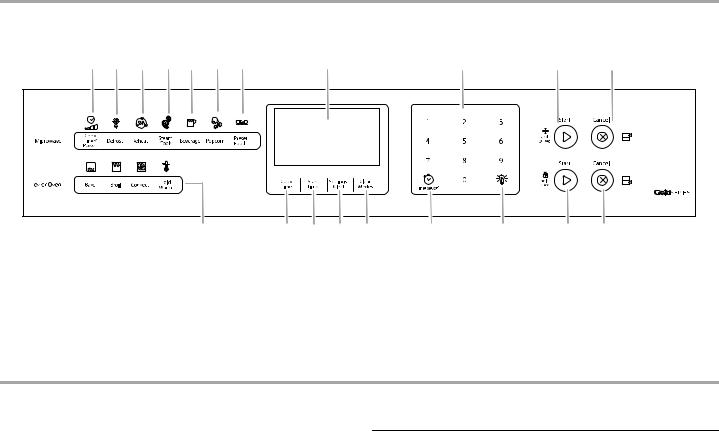Whirlpool WOC54E, WOC95E Use & Care Guide

BUILT-IN
MICROWAVE OVEN
Use & Care Guide
For questions about features, operation/performance, parts, accessories or service, call: 1-800-253-1301.
or visit our website at...
www.whirlpool.com
FOUR À MICROONDES ENCASTRÉ
Guide d’utilisation et d’entretien
Pour des questions à propos des caractéristiques, du fonctionnement/ rendement, des pièces, accessoires ou service, composez le :
1-800-807-6777.
ou visitez notre site Web www.whirlpoolappliances.ca
Table of Contents/Table des matières.......... |
2 |
Models/Modèles
WOC54E WOC95E
W10354188C

TABLE OF CONTENTS |
|
MICROWAVE OVEN SAFETY........................................................ |
2 |
Electrical Requirements ............................................................... |
4 |
PARTS AND FEATURES................................................................ |
5 |
MICROWAVE OVEN CONTROL.................................................... |
6 |
MICROWAVE OVEN USE .............................................................. |
6 |
Food Characteristics.................................................................... |
6 |
Cooking Guidelines...................................................................... |
7 |
Cookware and Dinnerware .......................................................... |
7 |
Aluminum Foil and Metal ............................................................. |
7 |
Microwave Cooking Power.......................................................... |
7 |
Cook Time/Power ........................................................................ |
8 |
Sensor Cook................................................................................. |
8 |
Preset Foods ................................................................................ |
8 |
Reheat .......................................................................................... |
9 |
Defrost.......................................................................................... |
9 |
Popcorn...................................................................................... |
10 |
Beverage .................................................................................... |
10 |
Steam Cook ............................................................................... |
11 |
MICROWAVE OVEN CARE.......................................................... |
12 |
General Cleaning........................................................................ |
12 |
TROUBLESHOOTING .................................................................. |
13 |
ASSISTANCE OR SERVICE......................................................... |
14 |
In the U.S.A. ............................................................................... |
14 |
Accessories ................................................................................ |
14 |
In Canada ................................................................................... |
14 |
WARRANTY .................................................................................. |
15 |
TABLE DES MATIÈRES |
|
SÉCURITÉ DU FOUR À MICRO-ONDES.................................... |
17 |
Spécifications électriques ........................................................ |
19 |
PIÈCES ET CARACTÉRISTIQUES .............................................. |
19 |
MODULE DE COMMANDE DU FOUR À MICRO-ONDES ........ |
20 |
UTILISATION DU FOUR À MICRO-ONDES ............................... |
20 |
Caractéristiques des aliments.................................................... |
20 |
Guide de cuisson........................................................................ |
21 |
Ustensiles de cuisson et vaisselle.............................................. |
21 |
Papier d’aluminium et métal....................................................... |
21 |
Puissance de cuisson des micro-ondes.................................... |
22 |
Cook Time/Power....................................................................... |
22 |
Cuisson par détection ................................................................ |
22 |
Preset Foods (aliments pré-programmés) ................................. |
23 |
Réchauffage ............................................................................... |
23 |
Defrost (décongélation) .............................................................. |
24 |
Popcorn (maïs soufflé)................................................................ |
25 |
Boisson....................................................................................... |
25 |
Cuisson à la vapeur.................................................................... |
26 |
ENTRETIEN DU FOUR À MICRO-ONDES ................................. |
27 |
Nettoyage général ...................................................................... |
27 |
DÉPANNAGE................................................................................. |
28 |
ASSISTANCE OU SERVICE......................................................... |
29 |
Aux États-Unis............................................................................ |
29 |
Accessoires ................................................................................ |
29 |
Au Canada.................................................................................. |
29 |
GARANTIE..................................................................................... |
30 |
MICROWAVE OVEN SAFETY
Your safety and the safety of others are very important.
We have provided many important safety messages in this manual and on your appliance. Always read and obey all safety messages.
This is the safety alert symbol.
This symbol alerts you to potential hazards that can kill or hurt you and others.
All safety messages will follow the safety alert symbol and either the word “DANGER” or “WARNING.” These words mean:
You can be killed or seriously injured if you don't immediately follow instructions.
You can be killed or seriously injured if you don't follow instructions.
All safety messages will tell you what the potential hazard is, tell you how to reduce the chance of injury, and tell you what can happen if the instructions are not followed.
2

IMPORTANT SAFETY INSTRUCTIONS
When using electrical appliances basic safety precautions should be followed, including the following:
WARNING: To reduce the risk of burns, electric shock, fire, injury to persons, or exposure to excessive microwave energy:
■Read all instructions before using the microwave oven.
■Read and follow the specific “PRECAUTIONS TO AVOID POSSIBLE EXPOSURE TO EXCESSIVE MICROWAVE ENERGY” found in this section.
■The microwave oven must be grounded. Connect only to properly grounded outlet. See “GROUNDING INSTRUCTIONS” found in this section.
■Install or locate the microwave oven only in accordance with the provided Installation Instructions.
■Some products such as whole eggs in the shell and sealed containers – for example, closed glass jars – may explode and should not be heated in the microwave oven.
■Use the microwave oven only for its intended use as described in this manual. Do not use corrosive chemicals or vapors in the microwave oven. This type of oven is specifically designed to heat, cook, or dry food. It is not designed for industrial or laboratory use.
■Oversized foods or oversized metal utensils should not be inserted in the microwave oven as they may create a fire or risk of electric shock.
■Do not clean with metal scouring pads. Pieces can burn off the pad and touch electrical parts involving a risk of electric shock.
■Do not store any materials, other than manufacturer's recommended accessories, in this oven when not in use.
■Do not operate the microwave oven if it has a damaged cord or plug, if it is not working properly, or if it has been damaged or dropped.
■Do not deep fry in oven. Microwavable utensils are not suitable and it is difficult to maintain appropriate deep frying temperatures.
■Do not use paper products when appliance is operated in the “PAN BROWN” mode.
■Do not cover racks or any other part of the oven with metal foil. This will cause overheating of the oven.
■As with any appliance, close supervision is necessary when used by children.
■The microwave oven should be serviced only by qualified service personnel. Contact nearest authorized service company for examination, repair, or adjustment.
■Do not cover or block any openings on the microwave oven.
■Liquids, such as water, coffee, or tea are able to be overheated beyond the boiling point without appearing to be boiling. Visible bubbling or boiling when the container is removed from the microwave oven is not always present. THIS COULD RESULT IN VERY HOT LIQUIDS SUDDENLY BOILING OVER WHEN THE CONTAINER IS DISTURBED OR A SPOON OR OTHER UTENSIL IS INSERTED INTO THE LIQUID.
To reduce the risk of injury to persons:
–Do not overheat the liquid.
–Stir the liquid both before and halfway through heating it.
–Do not use straight-sided containers with narrow necks.
–After heating, allow the container to stand in the microwave oven for a short time before removing the container.
–Use extreme care when inserting a spoon or other utensil into the container.
■Do not store the microwave oven outdoors. Do not use this product near water - for example, near a kitchen sink, in a wet basement, or near a swimming pool, and the like.
■See door surface cleaning instructions in the “Oven Care” section.
■To reduce the risk of fire in the oven cavity:
–Do not overcook food. Carefully attend the microwave oven if paper, plastic, or other combustible materials are placed inside the oven to facilitate cooking.
–Remove wire twist-ties from paper or plastic bags before placing bags in oven.
–If materials inside the oven should ignite, keep oven door closed, turn oven off, and disconnect the power cord, or shut off power at the fuse or circuit breaker panel.
–Do not use the cavity for storage purposes. Do not leave paper products, cooking utensils, or food in the cavity when not in use.
SAVE THESE INSTRUCTIONS
3

PRECAUTIONS TO AVOID POSSIBLE EXPOSURE TO EXCESSIVE MICROWAVE ENERGY
(a)Do not attempt to operate this oven with the door open since open-door operation can result in harmful exposure to microwave energy. It is important not to defeat or tamper with the safety interlocks.
(b)Do not place any object between the oven front face and the door or allow soil or cleaner residue to accumulate on sealing surfaces.
(c)Do not operate the oven if it is damaged. It is particularly important that the oven door close properly and that there is no damage to the:
(1)Door (bent),
(2)Hinges and latches (broken or loosened),
(3)Door seals and sealing surfaces.
(d)The oven should not be adjusted or repaired by anyone except properly qualified service personnel.
State of California Proposition 65 Warnings:
WARNING: This product contains one or more chemicals known to the State of California to cause cancer.
WARNING: This product contains one or more chemicals known to the State of California to cause birth defects or other reproductive harm.
Electrical Requirements
The microwave oven is connected to a 110 volt side of the 240 volt circuit required for the lower oven. If the incoming voltage to the microwave oven is less than 110 volts, cooking times may be longer. Have a qualified electrician check your electrical system.
GROUNDING INSTRUCTIONS
For a permanently connected microwave oven:
The microwave oven must be connected to a grounded, metallic, permanent wiring system, or an equipment grounding conductor should be run with the circuit conductors and connected to the equipment grounding terminal or lead on the microwave oven.
SAVE THESE INSTRUCTIONS
This device complies with Part 18 of the FCC Rules.
4

PARTS AND FEATURES
This manual covers different models. The oven you have purchased may have some or all of the items listed. The locations and appearances of the features shown here may not match those of your model.
G |
A |
H |
B |
I |
C |
D |
E |
F |
A.Electronic oven control
B.Model and serial number plate (position to be determined)
C.Light
D.Turntable
E.Metal shielded window
F.Lower oven (on combination models. See separate Use and Care Guide.)
G.Bottom vent
H.Door switch
I.Dual microwave emission
5

MICROWAVE OVEN CONTROL
A B C D E F G H I J K
L
A.Cook time/power
B.Defrost
C.Reheat
D.Steam cook
E.Beverage
F. Popcorn
G. Preset foods
M |
N |
O |
P |
Q |
R |
S |
T |
H. Electronic display |
O. Settings (lower oven) |
I. Temp/Time keypad |
P. Clean modes (lower oven) |
J. Microwave oven start |
Q. Timer set/off |
K. Microwave oven cancel |
R. Oven light |
L. Oven settings (lower oven) |
S. Lower oven start |
M. Cook time (lower oven) |
T. Lower oven cancel |
N. Start time (lower oven) |
|
MICROWAVE OVEN USE
A magnetron in the microwave oven produces microwaves which reflect off the metal floor, walls and ceiling and pass through the turntable and appropriate cookware to the food. Microwaves are attracted to and absorbed by fat, sugar and water molecules in the food, causing them to move, producing friction and heat which cooks the food.
■To avoid damage to the microwave oven, do not lean on or allow children to swing on the microwave oven door.
■To avoid damage to the microwave oven, do not operate microwave oven when it is empty.
■Baby bottles and baby food jars should not be heated in microwave oven.
■Clothes, flowers, fruit, herbs, wood, gourds, paper, including brown paper bags and newspaper, should not be dried in microwave oven.
■Paraffin wax will not melt in the microwave oven because it does not absorb microwaves.
■Use oven mitts or pot holders when removing containers from microwave oven.
■Do not overcook potatoes. At the end of the recommended cook time, potatoes should be slightly firm. Let potatoes stand for 5 minutes. They will finish cooking while standing.
■Do not cook or reheat whole eggs inside the shell. Steam buildup in whole eggs may cause them to burst, requiring significant cleanup of microwave oven cavity. Cover poached eggs and allow a standing time.
Food Characteristics
When microwave cooking, the amount, size and shape, starting temperature, composition and density of the food affect cooking results.
Amount of Food
The more food heated at once, the longer the cook time needed. Check for doneness and add small increments of time if necessary.
Size and Shape
Smaller pieces of food will cook more quickly than larger pieces, and uniformly shaped foods cook more evenly than irregularly shaped food.
Starting Temperature
Room temperature foods will heat faster than refrigerated foods, and refrigerated foods will heat faster than frozen foods.
Composition and Density
Foods high in fat and sugar will reach a higher temperature, and will heat faster than other foods. Heavy, dense foods, such as meat and potatoes, require a longer cook time than the same size of a light, porous food, such as cake.
6

Cooking Guidelines
Covering
Covering food helps retain moisture, shorten cook time and reduce spattering. Use the lid supplied with cookware. If a lid is not available, wax paper, paper towels or plastic wrap approved for microwave ovens may be used. Plastic wrap should be turned back at one corner to provide an opening to vent steam. Condensation on the door and cavity surfaces is normal during heavy cooking.
Stirring and Turning
Stirring and turning redistribute heat evenly to avoid overcooking the outer edges of food. Stir from outside to center. If possible, turn food over from bottom to top.
Arranging
If heating irregularly shaped or different sized foods, arrange the thinner parts and smaller sized items toward the center. If cooking several items of the same size and shape, place them in a ring pattern, leaving the center of the ring empty.
Piercing
Before heating, use a fork or small knife to pierce or prick foods that have a skin or membrane, such as potatoes, egg yolks, chicken livers, hot dogs, and sausage. Prick in several places to allow steam to vent.
Shielding
Use small, flat pieces of aluminum foil to shield the thin pieces of irregularly shaped foods, bones and foods such as chicken wings, leg tips and fish tail. See “Aluminum Foil and Metal” first.
Standing Time
Food will continue to cook by the natural conduction of heat even after the microwave cooking cycle ends. The length of standing time depends on the volume and density of the food.
Cookware and Dinnerware
Cookware and dinnerware must fit on the turntable. Always use oven mitts or pot holders when handling because any dish may become hot from heat transferred from the food. Do not use cookware and dinnerware with gold or silver trim. Use the following chart as a guide, then test before using.
MATERIAL |
RECOMMENDATIONS |
Aluminum Foil, |
See “Aluminum Foil and Metal” section. |
Metal |
|
|
|
Browning Dish |
Bottom must be at least 3/16" (5 mm) |
|
above the turntable. Follow manufacturer’s |
|
recommendations. |
|
|
Ceramic Glass, |
Acceptable for use. |
Glass |
|
|
|
China, |
Follow manufacturer’s recommendations. |
Earthenware |
|
|
|
Melamine |
Follow manufacturer’s recommendations. |
|
|
Paper: Towels, |
Use nonrecycled and those approved by |
Dinnerware, |
the manufacturer for microwave oven use. |
Napkins |
|
|
|
Plastic: Wraps, |
Use those approved by the manufacturer |
Bags, Covers, |
for microwave oven use. |
Dinnerware, |
|
Containers |
|
MATERIAL |
RECOMMENDATIONS |
Pottery and Clay |
Follow manufacturer’s recommendations. |
|
|
Silicone |
Follow manufacturer’s recommendations. |
Bakeware |
|
|
|
Straw, Wicker, |
Do not use in microwave oven. |
Wooden |
|
Containers |
|
|
|
Wax Paper |
Acceptable for use. |
|
|
To Test Cookware or Dinnerware for Microwave Use:
1.Place cookware or dinnerware in microwave oven with 1 cup (250 mL) of water beside it.
2.Cook at 100% cooking power for 1 minute.
Do not use cookware or dinnerware if it becomes hot and the water stays cool.
Aluminum Foil and Metal
Always use oven mitts or pot holders when removing dishes from the microwave oven.
Aluminum foil and some metal can be used in the microwave oven. If not used properly, arcing (a blue flash of light) can occur and cause damage to the microwave oven.
OK for Use
Racks and bakeware supplied with the microwave oven (on some models), aluminum foil for shielding, and approved meat thermometers may be used with the following guidelines:
■To avoid damage to the microwave oven, do not allow aluminum foil or metal to touch the inside cavity walls, ceiling or floor.
■Always use the turntable.
■To avoid damage to the microwave oven, do not allow contact with another metal object during microwave cooking.
Do Not Use
Metal cookware and bakeware, gold, silver, pewter, nonapproved meat thermometers, skewers, twist ties, foil liners such as sandwich wrappers, staples and objects with gold or silver trim or a metallic glaze should not be used in the microwave oven.
Microwave Cooking Power
Many recipes for microwave cooking specify which cooking power to use by percent, name or number. For example, 70%=7=Medium-High.
Use the following chart as a general guide for the suggested cooking power of specific foods.
PERCENT/NAME |
NUMBER |
USE |
|
|
|
100%, High |
10 |
Quick heating convenience |
(default setting) |
|
foods and foods with high |
|
|
water content, such as soups, |
|
|
beverages and most |
|
|
vegetables. |
|
|
|
90% |
9 |
Cooking small, tender pieces |
|
|
of meat, ground meat, poultry |
|
|
pieces and fish fillets. |
Heating cream soups.
7

PERCENT/NAME |
NUMBER |
USE |
80% |
8 |
Heating rice, pasta or stirrable |
|
|
casseroles. |
|
|
Cooking and heating foods |
|
|
that need a cook power lower |
|
|
than high. For example, whole |
|
|
fish and meat loaf. |
|
|
|
70%, |
7 |
Reheating a single serving of |
Medium-High |
|
food. |
|
|
|
60% |
6 |
Cooking sensitive foods such |
|
|
as cheese and egg dishes, |
|
|
pudding and custards. |
|
|
Cooking non-stirrable |
|
|
casseroles, such as lasagna. |
|
|
|
50%, Medium |
5 |
Cooking ham, whole poultry |
|
|
and pot roasts. |
|
|
Simmering stews. |
|
|
|
40% |
4 |
Melting chocolate. |
|
|
Heating bread, rolls and |
|
|
pastries. |
|
|
|
30%, Medium- |
3 |
Defrosting bread, fish, meats, |
Low, Defrost |
|
poultry and precooked foods. |
|
|
|
20% |
2 |
Softening butter, cheese, and |
|
|
ice cream. |
|
|
|
10%, Low |
1 |
Taking chill out of fruit. |
Cook Time/Power
To Use:
1.Put food into oven and close door.
2.Press COOK TIME/POWER.
“Cook Time” will scroll in the upper text area. “Set Time or press again to Set Power” will scroll in the lower text area.
Press the Temp/Time keypad to enter the desired cook time.
3.Press COOK TIME/POWER a second time to set cook power. “Cook Power” will scroll in the upper text area.
Press the Temp/Time keypad to select the desired cook power.
4.Press START.
Sensor Cook
You can stop the oven during a cycle by opening the door. The oven stops heating and the fan stops, but the light stays on. To restart cooking, close the door and touch START.
If you do not want to continue cooking, close the door and the light goes off, or touch UPPER CANCEL.
During the Sensor Cook function, a sensor automatically adjusts the cook time and power level.
The microwave oven display will show the time countdown once the sensor identifies the cooking duration.
If the microwave oven door is opened during a sensor function, the microwave oven will turn off and any additional operations will be canceled.
For best cooking performance:
Before using a Sensor Cook function, make sure power has been supplied to the microwave oven for at least 2 minutes, the room temperature is not above 95°F (35°C), and the outside of the cooking container and the microwave oven cavity are dry.
Many sensor cycles require covering foods. When covering foods with plastic wrap, be sure to leave a large enough vent opening to allow steam to escape.
Preset Foods
Times and cooking power have been preset for certain microwavable foods. Use the following chart as a guide.
FOOD |
NUMBER |
QUANTITY |
|
PAD |
|
|
|
|
Baked Potato |
1 |
1-4 potatoes |
Pierce each potato |
|
|
several times with a |
|
|
fork. Place on a paper |
|
|
towel. Let stand |
|
|
5 minutes after cooking. |
|
|
|
|
|
Frozen Entrée |
2 |
10-21 oz (283-595 g) |
Remove from package. |
|
|
Loosen cover on 3 |
|
|
sides. Let stand |
|
|
3 minutes after cooking. |
|
|
|
|
|
Popcorn |
3 |
1.75 oz-3.5 oz (50-99g) |
For best results, do not |
|
|
use regular paper bags |
|
|
or glassware. Pop only |
|
|
1 package of popcorn |
|
|
at a time. Follow |
|
|
manufacturer's |
|
|
instructions when using |
|
|
a microwave popcorn |
|
|
popper. |
|
|
Listen for popping to |
|
|
slow to 1 pop every 1 or |
|
|
2 seconds, then stop |
|
|
the cycle. For best |
|
|
cooking results, do not |
|
|
repop unpopped |
|
|
kernels. For best |
|
|
results, use fresh bags |
|
|
of popcorn. Cooking |
|
|
results may vary by |
|
|
brand and fat content. |
|
|
|
|
|
Scrambled Eggs |
4 |
1-4 eggs |
Break eggs into a |
|
|
microwave-safe |
|
|
container with high sides. Add 1 tbs (15 mL) water per egg and beat. Cover with plastic wrap and vent. Stir and let stand 2-3 minutes after cooking.
To Use Preset Foods:
1.All the preset food options will scroll in the lower text area.
2.Press the appropriate Temp/Time keypad to select quantities.
3.Press START. The display with count down the cook time. When the stop time is reached, the oven will shut off automatically. If enabled, end-of-cycle tones will sound.
8

Reheat
Times and cooking power have been preset for certain microwavable foods. Use the following chart as a guide.
FOOD |
NUMBER |
Quantity |
|
PAD |
|
|
|
|
Manual |
1 |
Default power |
|
|
level 100%. |
|
|
|
Casserole |
2 |
1-4 cups |
Place in microwave-safe |
|
(250 mL-1 L) |
|
|
|
container. Cover with plastic |
|
|
wrap and vent. Stir and let |
|
|
stand 2-3 minutes after |
|
|
reheating. |
|
|
|
|
|
Dinner Plate |
3 |
8-16 oz |
Place food on plate. Cover |
|
(227-454 g) |
|
|
|
with plastic wrap and vent. |
|
|
Let stand 2-3 minutes after |
|
|
reheating. |
|
|
|
|
|
Pizza Slices |
4 |
1-3 slices |
Place on a paper towel. |
|
(3 oz [85 g] each) |
|
|
|
|
|
|
Sauce |
5 |
1-4 cups |
Place in microwave-safe |
|
(250 mL-1 L) |
|
|
|
container. Cover with plastic |
|
|
wrap and vent. Stir and let |
|
|
stand 2-3 minutes after |
|
|
reheating. |
|
|
|
|
|
Soup |
6 |
1-4 cups |
Place in microwave-safe |
(250 mL-1 L) |
|
|
container. Cover with plastic |
|
wrap and vent. Stir and let |
|
stand 2-3 minutes after |
|
reheating. |
|
|
|
To Reheat Foods:
1.Press REHEAT.
“Reheat” will scroll in the upper text area. All the preset food reheating options will scroll in the lower text area.
2.Press the appropriate Temp/Time keypad to select the desired preset food reheating option.
3.For Preset Foods, press the appropriate Temp/Time keypad to select quantities.
For Manual, press the appropriate Temp/Time keypad to set cook time.
Press the Reheat keypad to change cook power.
4.Press START. The display with count down the cook time. When the stop time is reached, the oven will shut off automatically. If enabled, end-of-cycle tones will sound.
Defrost
The Defrost feature can be used, or the microwave oven can be manually set to defrost by using 20% cook power.
■Unwrap foods and remove lids (from fruit juice) before defrosting. Remove any metal twist-ties and replace them with strings or elastic bands.
■If food is foil wrapped, remove foil and place it in a suitable container.
■Slit or pierce plastic pouches or packaging. Slit the skins, if any, of frozen food such as sausage.
■Bend plastic pouches of food to ensure even defrosting.
■Always underestimate defrosting time. If defrosted food is still icy in the center, return it to the microwave oven for more defrosting.
■The length of defrosting time varies according to how solidly the food is frozen.
■Shallow packages will defrost more quickly than deep blocks.
■Separate food pieces as soon as possible during or at the end of a cycle for more even defrosting.
■Foods left outside the freezer for more than 20 minutes or frozen ready-made food should not be defrosted using the Custom Defrost feature, but should be defrosted manually.
■Use small pieces of aluminum foil to shield parts of food such as chicken wings, leg tips and fish tails. See “Aluminum Foil and Metal” first.
DEFROST CHART
The Custom Defrost system has 6 categories: Manual, Weight Unknown, Bread, Fish-Seafood, Meats and Poultry. Use the following chart as a guide.
FOOD |
CODE |
WEIGHT OR QUANTITY |
SETTING |
|
|
|
|
|
Manual |
1 |
0.1-6.6 lbs (45 g-3 kg) |
|
|
|
Weight |
2 |
See Weight Unknown Chart |
Unknown |
|
|
|
|
|
Meat* |
3 |
0.1-6.6 lbs (45 g-3 kg) |
|
|
|
Poultry* |
4 |
0.1-6.6 lbs (45 g-3 kg) |
|
|
|
Bread* |
5 |
0.1-2 lbs (45 g-0.9 kg) |
|
|
|
Fish/Seafood* |
6 |
0.1-6.6 lbs (45 g-3 kg) |
|
|
|
*See Weight Unknown chart at end of “Defrost” section for cuts, sizes, and instructions.
To Use Defrost:
1.Press DEFROST.
“Defrost” will scroll in the upper text area.
2.Press the appropriate Temp/Time keypad to select the desired defrost option and weight or quantity.
3.Touch number pads from the Defrost chart to select the weight or quantity.
4.Press START.
5.Press CANCEL or open the microwave oven door to stop the Defrost cycle.
9

Weight Unknown Chart
Use the following chart as a guide when defrosting bread, fish, meat, or poultry.
Food |
|
Setting |
Quantity |
Meats |
Ground |
|
1-4 cups (236 mL-1 L) |
|
Chops |
Small |
1-6 pieces |
|
|
Medium |
1-6 pieces |
|
|
Large |
1-4 pieces |
|
Steak |
Small |
1-6 pieces |
|
|
Medium |
1-4 pieces |
|
|
Large |
1-2 pieces |
|
|
|
|
Poultry |
Breast |
|
1-6 pieces |
|
Ground |
|
1-4 cups (236 mL-1 L) |
|
Pieces |
Small |
1-6 pieces |
|
|
Medium |
1-6 pieces |
|
|
Large |
1-6 pieces |
|
|
|
|
Bread |
Bagel |
Small |
1-8 pieces |
|
|
Medium |
1-6 pieces |
|
|
Large |
1-6 pieces |
|
Muffin |
Small |
4-16 pieces |
|
|
Medium |
1-6 pieces |
|
|
Large |
1-6 pieces |
|
Roll |
Small |
2-8 pieces |
|
|
Medium |
1-6 pieces |
|
|
Large |
1-6 pieces |
|
|
|
|
Fish/ |
Fillet |
|
1-6 pieces |
Seafood |
Steak |
|
1-4 pieces |
|
|
||
|
Shrimp |
|
1-4 cups (236 mL-1 L) |
|
Scallops |
|
1-4 cups (236 mL-1 L) |
|
|
|
|
Popcorn
NOTE: During Popcorn function, as with all microwave cooking functions, the microwave oven should be attended at all times. Listen for popping to slow to 1 pop every 1 or 2 seconds, then stop the cycle.
■To avoid damage to the microwave oven, do not use regular paper bags or glass utensils.
■Pop only 1 package of popcorn at a time.
■Follow manufacturer’s instructions when using a microwave popcorn popper.
■For best cooking results, do not try to pop unpopped kernels.
■Use fresh bags of popcorn for optimal results.
■Cooking results may vary by brand and fat content.
■The microwave oven uses the sensor to determine sizes that can be popped: 1.75-3.5 oz (50-99 g) bags.
To use POPCORN:
1.Press POPCORN. “Popcorn” will scroll in the upper text area.
2.Press START. When the stop time is reached, the oven will shut off automatically. If enabled, end-of-cycle tones will sound. (There won't be a countdown. It will display “Sensing” during the entire cycle.)
3.Press START
4.Press CANCEL or open the microwave oven door to stop the Popcorn cycle.
Beverage
Use Beverage to reheat at serving temperature.
To Use:
1.Press BEVERAGE.
“Beverage” will scroll in the upper text area.
2.Press the appropriate Temp/Time keypad to select the quantity.
3.Press START.
IMPORTANT: Heated liquids can splash out during and after heating. A wooden stir stick placed in the cup or bowl during heating may help avoid this.
4.Press CANCEL or open the microwave oven door to stop the Beverage cycle.
Use the following guide when reheating beverages
FOOD |
Quantity |
Beverage |
1-2 cups (250 mL-500 mL) |
Do not cover. |
|
|
|
10
